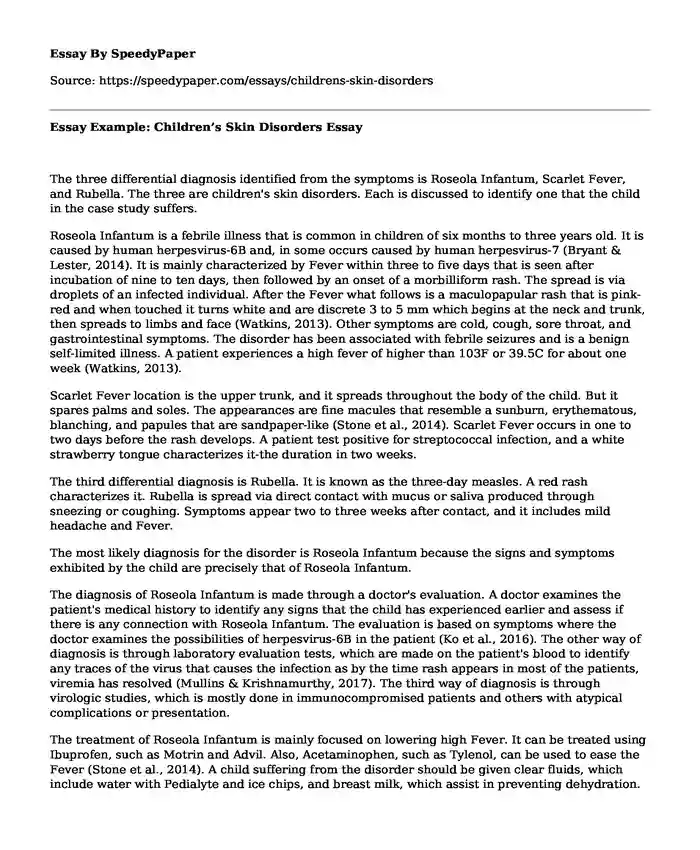
| Type of paper: | Essay |
| Categories: | Knowledge Medicine Child development Disorder |
| Pages: | 3 |
| Wordcount: | 660 words |
The three differential diagnosis identified from the symptoms is Roseola Infantum, Scarlet Fever, and Rubella. The three are children's skin disorders. Each is discussed to identify one that the child in the case study suffers.
Roseola Infantum is a febrile illness that is common in children of six months to three years old. It is caused by human herpesvirus-6B and, in some occurs caused by human herpesvirus-7 (Bryant & Lester, 2014). It is mainly characterized by Fever within three to five days that is seen after incubation of nine to ten days, then followed by an onset of a morbilliform rash. The spread is via droplets of an infected individual. After the Fever what follows is a maculopapular rash that is pink-red and when touched it turns white and are discrete 3 to 5 mm which begins at the neck and trunk, then spreads to limbs and face (Watkins, 2013). Other symptoms are cold, cough, sore throat, and gastrointestinal symptoms. The disorder has been associated with febrile seizures and is a benign self-limited illness. A patient experiences a high fever of higher than 103F or 39.5C for about one week (Watkins, 2013).
Scarlet Fever location is the upper trunk, and it spreads throughout the body of the child. But it spares palms and soles. The appearances are fine macules that resemble a sunburn, erythematous, blanching, and papules that are sandpaper-like (Stone et al., 2014). Scarlet Fever occurs in one to two days before the rash develops. A patient test positive for streptococcal infection, and a white strawberry tongue characterizes it-the duration in two weeks.
The third differential diagnosis is Rubella. It is known as the three-day measles. A red rash characterizes it. Rubella is spread via direct contact with mucus or saliva produced through sneezing or coughing. Symptoms appear two to three weeks after contact, and it includes mild headache and Fever.
The most likely diagnosis for the disorder is Roseola Infantum because the signs and symptoms exhibited by the child are precisely that of Roseola Infantum.
The diagnosis of Roseola Infantum is made through a doctor's evaluation. A doctor examines the patient's medical history to identify any signs that the child has experienced earlier and assess if there is any connection with Roseola Infantum. The evaluation is based on symptoms where the doctor examines the possibilities of herpesvirus-6B in the patient (Ko et al., 2016). The other way of diagnosis is through laboratory evaluation tests, which are made on the patient's blood to identify any traces of the virus that causes the infection as by the time rash appears in most of the patients, viremia has resolved (Mullins & Krishnamurthy, 2017). The third way of diagnosis is through virologic studies, which is mostly done in immunocompromised patients and others with atypical complications or presentation.
The treatment of Roseola Infantum is mainly focused on lowering high Fever. It can be treated using Ibuprofen, such as Motrin and Advil. Also, Acetaminophen, such as Tylenol, can be used to ease the Fever (Stone et al., 2014). A child suffering from the disorder should be given clear fluids, which include water with Pedialyte and ice chips, and breast milk, which assist in preventing dehydration. The treatment is aimed to relieve symptoms. In a critical situation, the patients can be treated with antiviral drugs ganciclovir.
References
Bryant, P. A., & Lester, C. M. (2014). Acute childhood exanthems. Medicine, 42(1), 52-56. https://doi.org/10.1016/j.mpmed.2013.10.002
Ko, H. R., Shin, S. M., Park, S. W., Ko, H. R., Shin, S. M., & Park, S. W. (2016). Predicting factors of roseola infantum infected with human herpesvirus six from urinary tract infection. Childhood Kidney Diseases, 20(2), 69-73. http://chikd.org/journal/view.php?number=640
Mullins, T. B., & Krishnamurthy, K. (2017). Roseola Infantum. https://europepmc.org/article/med/28846307
Stone, R. C., Micali, G. A., & Schwartz, R. A. (2014). Roseola infantum and its causal human herpesviruses. International Journal of Dermatology, 53(4), 397-403. https://doi.org/10.1111/ijd.12310
Watkins, J. (2013). Diagnosing rashes, part 4: Generalized rashes with Fever. Practice Nursing, 24(7), 335-342. https://doi.org/10.12968/pnur.2013.24.7.335
Cite this page
Essay Example: Children's Skin Disorders. (2023, May 01). Retrieved from https://speedypaper.com/essays/childrens-skin-disorders
Request Removal
If you are the original author of this essay and no longer wish to have it published on the SpeedyPaper website, please click below to request its removal:
- Leadership Skills in Religion - Essay Example
- Annotated Bibliography Example on the Inflation Rule in the NFL
- Essay Example on the Video about Legalizing Marijuana
- Discussion Essay Sample on the Clinton Foundation
- Essay Example on Importance of Global Marketing of Jim Beam Brand
- Essay Example. Media and Stereotypes of Underrepresented Groups
- Essay Example. Effects of Afghanistan War on People
Popular categories




